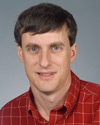 Steven W. Squyres |
2011 G.K. Gilbert Award
Presented to Steven W. Squyres
Citation by Laurence A. Soderblom
Steve Squyres’ career is rich in contributions to planetary science with fundamental research into the chemistry, physics, and geology of bodies ranging from Venus to Mars, from comets to asteroids, and across the myriad of outer-planet satellites. Threaded through his career has been a keen interest in searching for evidence of liquid water and potential habitats, coupled to the possible emergence of life beyond Earth. Europa and Mars became the early foci of his passion. Steve has enormously advanced our understanding of the role of water in the geological and climatic history of Mars—probably more than any other planetary scientist. Pursuit of these fundamental Mars science goals became a personal, career-long crusade. In the end he has laid down a new scientific foundation for the exploration of Mars; that crusade I chronicle here.
His early career focused on geomorphic evidence for liquid water and ice in Mars’ geologic past, arguing that many features signaled presence of ice; such ice is now confirmed by Mars Odyssey gamma ray and neutron measurements and by Mars Reconnaissance Orbiter’s subsurface radar observations. He later hypothesized that ancient valley networks formed in the Noachian evidenced abundant ice-covered lakes. From modeling efforts to understand the physics and chemistry and stability of lakes and springs against freezing, he concluded that a warmer and wetter period in Mars’ early history was required to explain the lakes. Squyres presented a lecture entitled “Water on Mars” in accepting the 1989 Urey Prize from the American Astronomical Society.
In the 1990s Steve became a strong spokesman for in situ chemical and mineralogical measurements feeling our insight into Mars’ early history was weakly based on geomorphology. He began promoting both in situ and remote methods that could definitively ascertain the chemistry and mineralogy of the Martian surface, including gamma ray, x-ray, alpha particle, Raman, and infrared spectroscopy that could be used on landers, rovers, and orbiters. He became a science team member on gamma ray and x-ray fluorescence experiments on several Mars and asteroid missions. Forging alliances with the scientific leaders in these fields, he assembled a scientific team and a suite of instruments that grew into the Athena payload, ultimately the tools of two robotic field geologists, the Mars Exploration Rovers.
Squyres was now poised to lead a mission to Mars to peer directly into its ancient geologic past to answer the key scientific questions that had so long driven him. The MER results have dramatically enriched our view of the enormous complexity of Martian geological history and transformed our understanding of how Mars has evolved. At Gusev crater Spirit uncovered a complex variety of aqueous alteration products; in Meridiani Opportunity discovered sedimentary rocks deposited in open shallow lakes. There is little doubt that warmer, wetter periods had to exist on ancient Mars. Squyres’ career-long quest to reveal Mars’ early environments has been a monumental and singular personal feat with a scientific impact that has indelibly reshaped the future exploration of Mars—both by robots and by humans.
 2011 G.K. Gilbert Award — Response by Steven W. Squyres
2011 G.K. Gilbert Award — Response by Steven W. Squyres
This award is given very generously, and received very gratefully. It’s especially gratifying to receive it in the presence of so many of the friends and colleagues that I’ve worked with over the years.
I started down this road a long time ago, and I’ve had the good fortune to be guided by many people along the way. Joe Veverka was my advisor in grad school, and he taught me both how to do science and, by his example, how to be a generous mentor and colleague. Carl Sagan taught me physics, and also taught me the importance of communicating science in a way that anyone can understand. I also had the great good fortune to work with Gene Shoemaker when I was in grad school; Gene’s enthusiasm for science has been an inspiration to me ever since. And my postdoctoral advisor at Ames was Ray Reynolds. Much of my early work in planetary science began with ideas that came from him.
I’ve also gotten to work with some of the best in the business on a number of NASA flight projects. A long time ago, as a brand-new grad student working on the Voyager project, I decided that Larry Soderblom was the guy I wanted to be like when I grew up. I’m still working on that one. Ray Arvidson has been my partner and friend through all the years that we’ve worked on Spirit and Opportunity, from the very beginning right up to yestersol. And of course the rover science is the product of the whole Athena science team, more than a hundred scientists that I’m very proud to be one of.
Too often in this business, we scientists have a tendency to forget about the people who make what we do possible—the engineers who build our instruments and our spacecraft. All the science done by the MER rovers was made possible by people like Pete Theisinger, Richard Cook, Matt Wallace, my good friend Barry Goldstein, and literally thousands of others. I am deeply in their debt, as are we all.
Another thing I think maybe we forget sometimes is how lucky we are to do what we do. We’re living in an extraordinary time, when we’re taking the first steps off our home planet. It’s a time that I think in the hindsight of history will be seen as one of humanity’s great bursts of exploration and discovery. And we not only get to witness it, we get to be part of it. I’m deeply grateful for that opportunity, and even more grateful to be able to have shared the adventure with so many of my colleagues and friends. Thank you.
